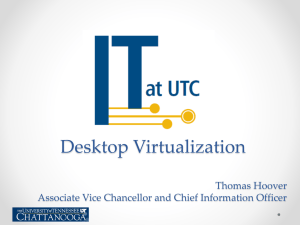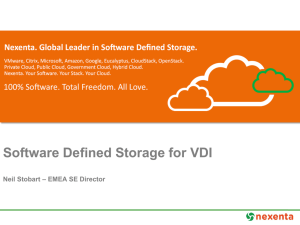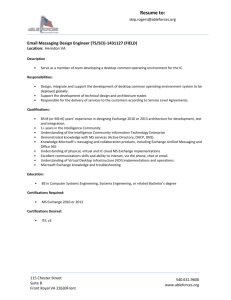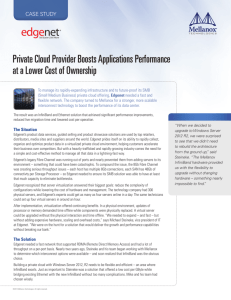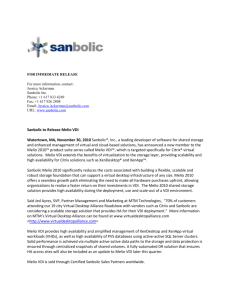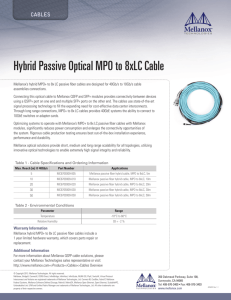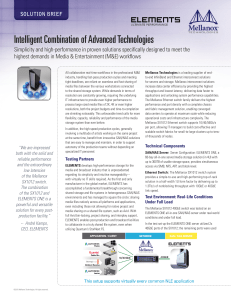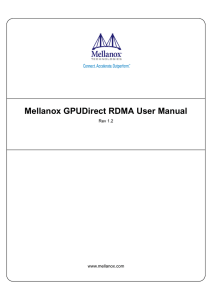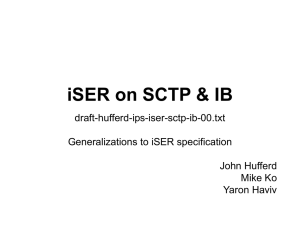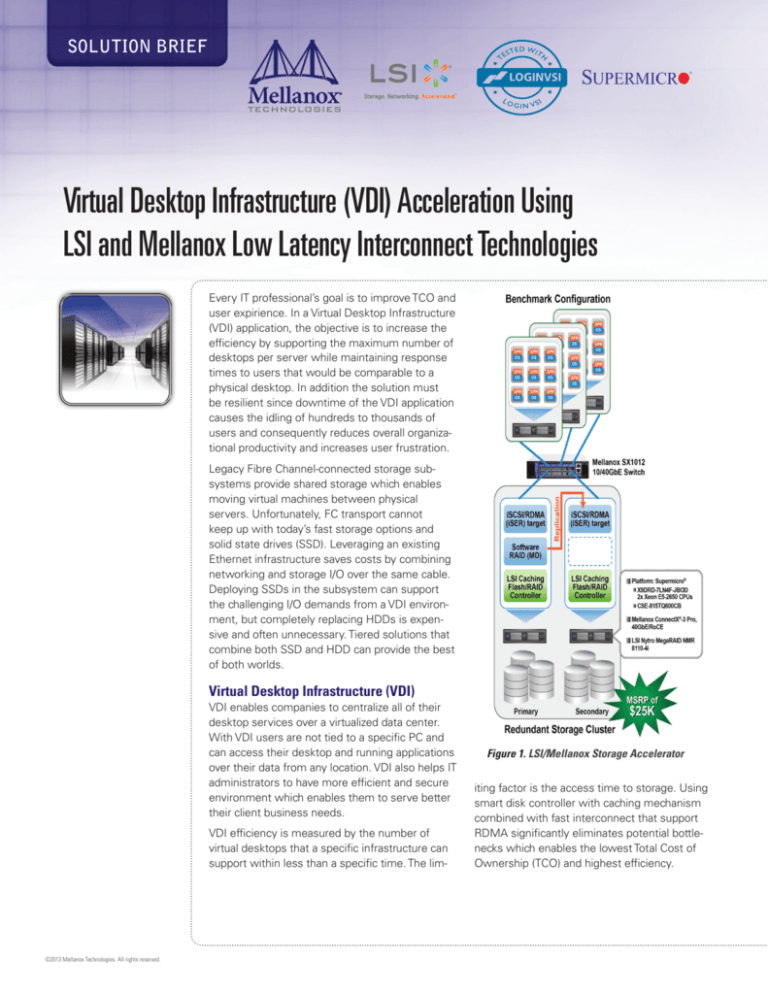
SOLUTION BRIEF
Virtual Desktop Infrastructure (VDI) Acceleration Using
LSI and Mellanox Low Latency Interconnect Technologies
Every IT professional’s goal is to improve TCO and
user expirience. In a Virtual Desktop Infrastructure
(VDI) application, the objective is to increase the
efficiency by supporting the maximum number of
desktops per server while maintaining response
times to users that would be comparable to a
physical desktop. In addition the solution must
be resilient since downtime of the VDI application
causes the idling of hundreds to thousands of
users and consequently reduces overall organizational productivity and increases user frustration.
Legacy Fibre Channel-connected storage subsystems provide shared storage which enables
moving virtual machines between physical
servers. Unfortunately, FC transport cannot
keep up with today’s fast storage options and
solid state drives (SSD). Leveraging an existing
Ethernet infrastructure saves costs by combining
networking and storage I/O over the same cable.
Deploying SSDs in the subsystem can support
the challenging I/O demands from a VDI environment, but completely replacing HDDs is expensive and often unnecessary. Tiered solutions that
combine both SSD and HDD can provide the best
of both worlds.
Virtual Desktop Infrastructure (VDI)
VDI enables companies to centralize all of their
desktop services over a virtualized data center.
With VDI users are not tied to a specific PC and
can access their desktop and running applications
over their data from any location. VDI also helps IT
administrators to have more efficient and secure
environment which enables them to serve better
their client business needs.
VDI efficiency is measured by the number of
virtual desktops that a specific infrastructure can
support within less than a specific time. The lim-
©2013 Mellanox Technologies. All rights reserved.
Figure 1. LSI/Mellanox Storage Accelerator
iting factor is the access time to storage. Using
smart disk controller with caching mechanism
combined with fast interconnect that support
RDMA significantly eliminates potential bottlenecks which enables the lowest Total Cost of
Ownership (TCO) and highest efficiency.
SOLUTION BRIEF
Low Latency Solutions
Low latency data requests from storage or other servers
are the key to enabling more VDI sessions without increasing user response times. LSI Corporation and Mellanox Technologies are leaders in low latency storage and
networking solutions and have combined LSI storage
solutions with Mellanox high-performance networking to
provide a Storage Accelerator. LSI’s Nytro MegaRAID application acceleration card provides flash storage using a
server’s PCIe backplane. It uses an economical mix of flash
and HDD storage and uses adaptive caching algorithms
to cache heavily referenced areas of storage. Mellanox’s
40GbE with Remote Direct Memory Access (RDMA) technology provides high bandwidth and enables the fastest
and most reliable data transfers with minimal server compute resources. By using the iSCSI protocol with an RDMA
transport (a standard called iSER) instead of iSCSI over
TCP/IP, it leads to significantly faster storage latency and
bandwidth while maintaining the familiarity of iSCSI management and utilities in the VMware vSphere environment.
RDMA over Converged Ethernet (RoCE)
RoCE utilizes advances in Ethernet to enable efficient
implementations of RDMA over Ethernet. It enables widespread deployment of RDMA technologies in mainstream
datacenter applications. RoCE-based network management is the same as that for any Ethernet network management, eliminating the need for IT managers to learn
new technologies.
The business advantages of RoCE for a data center are:
• No changes to data center infrastructure
• I/O unification on a single wire over 10/40 GbE networks
• Continuation of existing data center management infrastructure
• Reduction in power and cost savings
• Maintain existing and future application compatibility
• Significant CapEx and OpEx savings with a single chip
solution for I/O unification
iSCSI Extensions for RDMA (iSER)
iSCSI Extensions for RDMA (iSER) is an IETF standard
extension to the Internet Small Computer System Interface (iSCSI) protocol. It uses hardware Remote Direct
Memory Access (RDMA) for the iSCSI transaction delivery
mechanism. It basically uses the upper layers of iSCSI
for session management, discovery, recovery, and so on,
and is therefore compatible with all the features and func-
page 2
tions supported by iSCSI. However, using iSER eliminates
the bottleneck and provides unprecedented performance
through the following mechanisms:
• Eliminates data copying via RDMA technology
• CRC is calculated by hardware to reduce CPU overhead
while maintaining data integrity
• Works with message boundaries instead of streams, allowing faster protocol processing
• Transport protocol is fully implemented in hardware (requiring minimal CPU cycles per IO and driving extremely
low latency)
iSER implementations today can drive magnitudes faster
latency and bandwidth than traditional FC or iSCSI implementations.
Mellanox iSER driver for vSphere has been certified under
VMware’s Partner Verified and Supported Products (PVSP)
program and can be found at: http://www.vmware.com/resources/compatibility/vcl/partnersupport.php
High Performance Can Be Economical
To evaluate VDI performance using the LSI/Mellanox
Storage Accelerator (see Figure 1), a Supermicro X9DRD7LN4F-JBOD serverboard in a 1U Supermicro CSE-815TQ600CB chassis with a Xeon E5-2650 processor was used
running a Linux operating system. A Mellanox SX1012
12-port 40GbE switch in a half-width 1U form factor allows
multiple ESXi servers using iSER to communicate with the
Storage Target (which is based on an open source Linux
iSCSI and iSER target implementation). Mellanox ConnectX®-3 Pro adapter supports 40Gb/s RoCE storage connectivity between the servers. Providing data storage is a
Nytro MegaRAID NMR 8110-4i card which has 200GB of
on-card flash and eight SAS HDDs.
To facilitate continuous VDI operation, a secondary server
retains a copy of the storage on the primary server using
software mirroring across another iSER connection. If the
primary server fails, the secondary server supports storage
requests. Altogether, the MSRP for the hardware used
in this evaluation was about $25,000 for a fault-tolerant,
highly available, flash storage system with high performance 40GbE interconnects.
page 3
SOLUTION BRIEF
Figure 2. VDI Performance
Evaluating VDI Performance
Scaling for Additional Desktops
VDI performance was measured using Login VSI’s VDI load
generator which creates the actual workload of a typical
Windows user using Microsoft Office applications. Figure 2
shows 150 virtual desktop sessions running in parallel while
each user experiences less than 5 seconds in response
time. Booting all the 150 sessions was accomplished in
less than 6 minutes.
The Storage Target can easily scale the number of virtual
desktops. It can handle increments of 150 virtual desktops
connected to an vSphere server. Deriving from measured
key metrics, the Storage Target can support up to 1500
virtual desktops using two Nytro MegaRAID cards. More
desktops can be supported by adding Nytro MegaRAID
cards.
These results represent more than 2 times the efficiency
boost versus 10GbE and iSCSI over TCP/IP, in which only 60
virtual desktop sessions could run with 5 seconds response
time using the same setup.
Failover
Failover functionality was not implemented in this performance benchmarking. However, open-source implementations like Linux HA and Linux DRBD® have failure detection
and IP address migration, and could be used to add and
test this capability.
KEY SOLUTION ADVANTAGES
–– Maximizing number of virtual desktop per server with guaranteed response time
–– Most resilient scale-out solution minimizing downtime of business applications running over VDI
–– Improves data center efficiency by enabling higher performance and a lower cost of ownership
–– Consolidates LAN and SAN infrastructures into a single Mellanox high-performance interconnect
infrastructure of Ethernet and/or InfiniBand adapters, cable, and switches
350 Oakmead Parkway, Suite 100, Sunnyvale, CA 94085
Tel: 408-970-3400 • Fax: 408-970-3403
www.mellanox.com
© Copyright 2013. Mellanox Technologies. All rights reserved.
Mellanox, Mellanox logo, BridgeX, ConnectX, CORE-Direct, InfiniBridge, InfiniHost, InfiniScale, PhyX, SwitchX, Virtual Protocol Interconnect, and Voltaire are registered trademarks of Mellanox Technologies, Ltd. Connect-IB,
ExtendX, FabricIT, MLNX-OS, ScalableHPC, Unbreakable-Link, UFM and Unified Fabric Manager are trademarks of Mellanox Technologies, Ltd. All other trademarks are property of their respective owners.
1062SB Rev1.0

